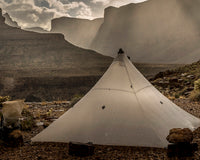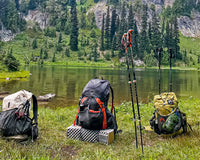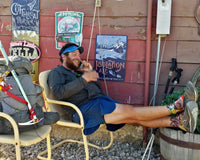
“How was your trip?”
“Great! Until my knee started to hurt. So we fell behind on our mileage plan. To make up for it, we didn’t take our layover day, and hiked into the night a couple of times. But then it got worse and my foot and back started to hurt. Between the pain and exhaustion, I lost my appetite and couldn’t eat. I was so miserable I couldn’t enjoy the views and the whole adventure started to feel kinda pointless.”
Don’t let this be your story. This is not fun. Not any kind of fun. Training for your adventures prepares your body, so that you can enjoy the environment, people, and activity itself. When you have enough physical fitness to handle unexpected challenges with grace, then this is how the story goes:
“Awesome! Some crazy shit went down and we had to add this epic detour and then help this stranded couple. After all that, we still made it to our destination and celebrated with a beautiful sunset dinner while laughing at how well we handled everything that went pear-shaped.”

So what are some tips for training your body for adventure?
1. Build Gradually
Less is more. While it is ideal to train for the athletic demands of your adventure, don’t injure yourself before you get to the trailhead. It is 100% better to be 30% undertrained than 10% overtrained. Start with whatever fitness you have and over weeks gradually increase the amount and intensity of your training.
2. Training Specificity

Do the movements you’ll be doing for your adventure. If your adventure is backpacking in the Smokies, then you should be training by hiking on trails with elevation changes while wearing your pack. That’s not always a practical accessible option, so other options are: doing a bunch of laps of the same hill in your city park, a zillion flights of stairs, or a bazillion step ups and downs on a bench. Find ways to mimic the activity, or even break the movements down and train them separately.
Other activities such as running, biking, paddling, climbing, swimming, strength training, etc., are all good general conditioning, and are considered cross-training, but would not prepare your body for the specific demands of a hiking adventure.
Specificity includes gear and conditions, such as time of day and climate. Training specificity doesn’t need to be all your training time — in fact, it shouldn’t be — but far too often this basic principle gets overlooked.
3. Address Imbalances
Some areas of your body are too stiff, some areas are too weak. Doing a lot of any one thing (sitting or hiking) will create imbalances.
Assess what movements need to be stronger for you. Maybe those are lateral or rotational movements, or shoulder stability, or hamstring strength to counter all that quad strength.
Assess what parts of you need more range of motion. Maybe your ankles and hips are super stiff from needing to be stable on trail, or your hip flexors and chest are stuck from either sitting at a desk or riding a bike.
Take the time to do the strength and stretching that will make your body more resilient.
4. Practice Skills

What are the less obvious yet still critical movements for your adventure? Make sure you practice and train those movements too.
For backpacking it is often taking the pack on and off and getting up and down from the ground. For paddling it is often getting in and out of the boat. For cycling it’s getting on and off the bike.
It’s easy to take these simple actions for granted but when you’re exhausted and a storm is threatening or it’s dark, this is when lacking that simple skill will get you hurt. Practice these skills so you can do them in different ways super smoothly and efficiently. Train the movement patterns so they are stronger and more durable even when you are tired and distracted.
5. Train Your Gut
Gastrointestinal (GI) distress will sap all of the strength from your training. Train your GI system to process the kind of food and hydration you’ll be using in the conditions you’ll be in.
Will you need to eat while walking, or in the middle of the night? Will you need to digest a lot more than usual, or much less? Will your GI and food systems need to work in extreme heat or cold? What kind of food can you choke down and digest even when you feel like crap?
When planning your food and water systems, make sure you put them into practice on some key physical training days.
6. Log Your Training

Write it down. Anywhere. How will you know if you’re doing enough, or too much, or the right things, or if it’s working, or what to try next time? I’ll say it again: Write. It. Down. Anywhere. There are a zillion apps for that. Or use a good old paper journal or calendar. Or make yourself a spreadsheet. Whatever you’ll actually use.
What should you write down?
- Date - when you did the thing.
- Title - what it was you did such as trail hike vs dog walk vs lake swim.
- Duration - time spent doing the thing. Distance or other metrics are optional.
This can get super complicated but the bottom line is having some data to help you reflect, assess, and make a better plan next time.
Of course, there are no guarantees you won’t get hurt. This is not medical advice. You should still be evaluated and cleared by a medical professional before taking on athletic training or adventures.
Also, make sure you do all of the other smart prep before a trip: select and test your gear, practice safety skills, and have a plan for communication, risk assessment, self-rescue and evacuation. Always expect the unexpected.
My adventure motto: Have fun, don’t die. Being well prepared really helps with both staying healthy and having fun.

Kym Zest is the owner of Zest Ed and author of Athletic Life Concepts - A Workbook. She coaches enthusiastic recreational endurance athletes to achieve their goals while teaching them about the process of training. Her husband, Will coaches outdoorsy people to be more prepared for their wilderness adventures. When not racing or adventuring, they live in an old apartment in Minneapolis with their kitty, Pigeon, where they enjoy books, beer, and bike and run commuting year-round. To purchase the workbook and learn more about Zest Ed go to Zested.net Interested in coaching or a consultation? Email kym@zested.net















1 comment
Todd
Good advice. I would add, Start Your Trip Easy, give your body time to adapt. If you are going a thru-hike, there is no need to bust out 20+ mile days starting day 1. Go easy for a week or so, then add miles.